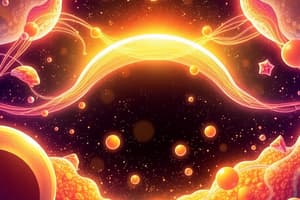Podcast
Questions and Answers
Carbohydrates generally have multiple ______ functional groups, so we never focus on those when naming them.
Carbohydrates generally have multiple ______ functional groups, so we never focus on those when naming them.
alcohol
Sugars will only have one aldehyde OR one ______ functional group.
Sugars will only have one aldehyde OR one ______ functional group.
ketone
We specify if a carbohydrate contains an aldehyde or ketone in the name by adding either an aldo- or ______- prefix.
We specify if a carbohydrate contains an aldehyde or ketone in the name by adding either an aldo- or ______- prefix.
keto
If a carbohydrate name starts with aldo-, you know that the functional group is an ______.
If a carbohydrate name starts with aldo-, you know that the functional group is an ______.
Most common ketoses have a ketone functional group on the ______ carbon in the chain.
Most common ketoses have a ketone functional group on the ______ carbon in the chain.
The ketose corresponding to the aldose D-xylose is ______.
The ketose corresponding to the aldose D-xylose is ______.
Molecules that are not superimposable on their mirror images are called optical isomers or ______.
Molecules that are not superimposable on their mirror images are called optical isomers or ______.
D-glucose and D-mannose are examples of ______, because they differ in configuration only at C-2.
D-glucose and D-mannose are examples of ______, because they differ in configuration only at C-2.
Sugars that differ in configuration at a single asymmetric center are called ______.
Sugars that differ in configuration at a single asymmetric center are called ______.
The three-dimensional arrangement of groups around a chiral carbon atom is referred to as ______.
The three-dimensional arrangement of groups around a chiral carbon atom is referred to as ______.
Alcohols react with aldehydes and ketones to form ______ and hemiketals, respectively.
Alcohols react with aldehydes and ketones to form ______ and hemiketals, respectively.
The cyclic forms of glucose and fructose with six- and five-membered rings are known as glucopyranose and ______, respectively.
The cyclic forms of glucose and fructose with six- and five-membered rings are known as glucopyranose and ______, respectively.
A sugar with a six-membered ring is known as a ______, in analogy with pyran.
A sugar with a six-membered ring is known as a ______, in analogy with pyran.
Sugars with five-membered rings are designated ______ in analogy with furan.
Sugars with five-membered rings are designated ______ in analogy with furan.
The configurations of the substituents to each carbon atom of sugar rings are conveniently represented by their ______ formulas.
The configurations of the substituents to each carbon atom of sugar rings are conveniently represented by their ______ formulas.
When hemiacetals and hemiketals are formed, the carbon atom that carried the carbonyl function becomes an ______ carbon atom.
When hemiacetals and hemiketals are formed, the carbon atom that carried the carbonyl function becomes an ______ carbon atom.
The name carbohydrate refers to "hydrate of carbon," which are the aldehydic or ketonic derivatives of polyhydroxy alcohols and their polymers having hemiacetal ______ linkages.
The name carbohydrate refers to "hydrate of carbon," which are the aldehydic or ketonic derivatives of polyhydroxy alcohols and their polymers having hemiacetal ______ linkages.
Brain cells, red blood cells, kidney medulla, lens, and cornea of the eye exclusively depend on carbohydrates, specifically ______, as their primary energy source.
Brain cells, red blood cells, kidney medulla, lens, and cornea of the eye exclusively depend on carbohydrates, specifically ______, as their primary energy source.
______ and deoxyribose sugars are essential components in the structural framework of RNA and DNA.
______ and deoxyribose sugars are essential components in the structural framework of RNA and DNA.
Cellulose, the main constituent of plant cell walls, is one of the most ______ organic compounds in the biosphere.
Cellulose, the main constituent of plant cell walls, is one of the most ______ organic compounds in the biosphere.
Carbohydrates linked to proteins and lipids play key roles in mediating interactions among cells and between cells and other elements in the cellular ______.
Carbohydrates linked to proteins and lipids play key roles in mediating interactions among cells and between cells and other elements in the cellular ______.
In animal cells, carbohydrates are mainly stored in the form of ______ and glucose, while in plant cells, they are stored as cellulose and starch.
In animal cells, carbohydrates are mainly stored in the form of ______ and glucose, while in plant cells, they are stored as cellulose and starch.
A carbohydrate with 3 carbons is called a ______, using the greek numeral prefix and the -ose suffix to denote its carbohydrate nature.
A carbohydrate with 3 carbons is called a ______, using the greek numeral prefix and the -ose suffix to denote its carbohydrate nature.
Although naming a carbohydrate as a ______ indicates it has six carbons, it does not specify the exact nature of the molecule, as there are multiple hexoses like glucose, galactose, and fructose.
Although naming a carbohydrate as a ______ indicates it has six carbons, it does not specify the exact nature of the molecule, as there are multiple hexoses like glucose, galactose, and fructose.
Bulky substituent groups on saccharide rings are more stable when they occupy ______ positions rather than axial positions.
Bulky substituent groups on saccharide rings are more stable when they occupy ______ positions rather than axial positions.
Among the D-aldohexoses, only β-D-glucose can adopt a conformation where all of its bulky groups are in an ______ position.
Among the D-aldohexoses, only β-D-glucose can adopt a conformation where all of its bulky groups are in an ______ position.
Two general rules dictate the conformation to be adopted by a given saccharide unit: Bulky substituent groups on rings are more stable when they occupy equatorial positions rather than axial positions, and ______ conformations are slightly more stable than boat conformations.
Two general rules dictate the conformation to be adopted by a given saccharide unit: Bulky substituent groups on rings are more stable when they occupy equatorial positions rather than axial positions, and ______ conformations are slightly more stable than boat conformations.
[Blank] is often referred to as the sugar of the body because of its central role in carbohydrate metabolism.
[Blank] is often referred to as the sugar of the body because of its central role in carbohydrate metabolism.
The molecular formula C6H12O6 is shared by both glucose and ______, but they differ in their structural arrangement.
The molecular formula C6H12O6 is shared by both glucose and ______, but they differ in their structural arrangement.
[Blank] is a component of glycoproteins and glycolipids and is produced during lactose synthesis in mammary glands.
[Blank] is a component of glycoproteins and glycolipids and is produced during lactose synthesis in mammary glands.
Hydrolysis of cane sugar, starch, lactose, and maltose in the body can yield ______, highlighting its importance as a metabolic intermediate.
Hydrolysis of cane sugar, starch, lactose, and maltose in the body can yield ______, highlighting its importance as a metabolic intermediate.
[Blank] is known as the sweetest monosaccharide and is commonly prepared through the hydrolysis of sucrose.
[Blank] is known as the sweetest monosaccharide and is commonly prepared through the hydrolysis of sucrose.
______ are vital constituents of many coenzymes and nucleic acids, and are also formed as transitional products throughout certain metabolic processes.
______ are vital constituents of many coenzymes and nucleic acids, and are also formed as transitional products throughout certain metabolic processes.
According to the number of carbon atoms they possess, simple sugars might be further divided into tetroses, trioses, ______ or heptoses, pentoses, and ketoses or aldoses based on whether the ketone or aldehyde groups are present.
According to the number of carbon atoms they possess, simple sugars might be further divided into tetroses, trioses, ______ or heptoses, pentoses, and ketoses or aldoses based on whether the ketone or aldehyde groups are present.
Cn (H₂O)n-1 is the general formula for ______.
Cn (H₂O)n-1 is the general formula for ______.
______ is formed as a transitional product of the action of amylases on starch and it contains two glucose residues in alpha 1, 4 linkages.
______ is formed as a transitional product of the action of amylases on starch and it contains two glucose residues in alpha 1, 4 linkages.
______ can be found in milk and produces D-galactose and D-glucose upon hydrolysis.
______ can be found in milk and produces D-galactose and D-glucose upon hydrolysis.
Cane sugar, also known as ______, is a disaccharide composed of fructose and glucose.
Cane sugar, also known as ______, is a disaccharide composed of fructose and glucose.
______ are formed throughout the metabolic breakdown of hexoses in the body.
______ are formed throughout the metabolic breakdown of hexoses in the body.
A constituent of the prosthetic polysaccharide of albumins, mucoproteins, and globulins is ______.
A constituent of the prosthetic polysaccharide of albumins, mucoproteins, and globulins is ______.
The hydrolysis of sucrose results in a change in ______ from dextro to levo.
The hydrolysis of sucrose results in a change in ______ from dextro to levo.
The mixture of fructose and glucose formed after the hydrolysis of sucrose is known as ______ sugar.
The mixture of fructose and glucose formed after the hydrolysis of sucrose is known as ______ sugar.
[Blank] catalyze the reaction of sucrose hydrolysis.
[Blank] catalyze the reaction of sucrose hydrolysis.
Trehalose is a non-reducing disaccharide composed of two ______ residues.
Trehalose is a non-reducing disaccharide composed of two ______ residues.
Polysaccharides, also known as ______, are complex carbohydrates formed by the polymerization of monosaccharide monomers and are linked by glycosidic bonds.
Polysaccharides, also known as ______, are complex carbohydrates formed by the polymerization of monosaccharide monomers and are linked by glycosidic bonds.
Flashcards
Carbonyl Group
Carbonyl Group
A functional group containing a carbon atom double-bonded to an oxygen atom (C=O). Sugars have either one aldehyde or one ketone functional group.
Aldose
Aldose
A carbohydrate with an aldehyde (R-CHO) as its carbonyl group.
Ketose
Ketose
A carbohydrate with a ketone (R-CO-R') as its carbonyl group.
Aldo- Prefix
Aldo- Prefix
Signup and view all the flashcards
Keto- Prefix
Keto- Prefix
Signup and view all the flashcards
Enantiomers
Enantiomers
Signup and view all the flashcards
Diastereoisomers
Diastereoisomers
Signup and view all the flashcards
Chiral Carbon
Chiral Carbon
Signup and view all the flashcards
Carbohydrates
Carbohydrates
Signup and view all the flashcards
Tissues solely dependent on carbohydrates
Tissues solely dependent on carbohydrates
Signup and view all the flashcards
Functions of carbohydrates
Functions of carbohydrates
Signup and view all the flashcards
Forms of carbohydrates
Forms of carbohydrates
Signup and view all the flashcards
Triose
Triose
Signup and view all the flashcards
Examples of Hexoses
Examples of Hexoses
Signup and view all the flashcards
Knowing a molecule is a hexose...
Knowing a molecule is a hexose...
Signup and view all the flashcards
Epimers
Epimers
Signup and view all the flashcards
Configuration (Stereochemistry)
Configuration (Stereochemistry)
Signup and view all the flashcards
Hemiacetal
Hemiacetal
Signup and view all the flashcards
Hemiketal
Hemiketal
Signup and view all the flashcards
Cyclic Hemiacetals and Hemiketals
Cyclic Hemiacetals and Hemiketals
Signup and view all the flashcards
Haworth Projection Formulas
Haworth Projection Formulas
Signup and view all the flashcards
Pyranose
Pyranose
Signup and view all the flashcards
Furanose
Furanose
Signup and view all the flashcards
Inversion (of Sucrose)
Inversion (of Sucrose)
Signup and view all the flashcards
Invert Sugar
Invert Sugar
Signup and view all the flashcards
Invertase
Invertase
Signup and view all the flashcards
Trehalose
Trehalose
Signup and view all the flashcards
Polysaccharides
Polysaccharides
Signup and view all the flashcards
Equatorial Substituents
Equatorial Substituents
Signup and view all the flashcards
Axial Substituents
Axial Substituents
Signup and view all the flashcards
Chair and Boat Conformations
Chair and Boat Conformations
Signup and view all the flashcards
Chair Conformation Stability
Chair Conformation Stability
Signup and view all the flashcards
Aldotriose
Aldotriose
Signup and view all the flashcards
Ketotriose
Ketotriose
Signup and view all the flashcards
Glucose
Glucose
Signup and view all the flashcards
Fructose
Fructose
Signup and view all the flashcards
Disaccharide
Disaccharide
Signup and view all the flashcards
Lactose
Lactose
Signup and view all the flashcards
Sucrose
Sucrose
Signup and view all the flashcards
Study Notes
- Carbohydrates, also known as "hydrates of carbon," are aldehydic or ketonic derivatives of polyhydroxy alcohols with hemiacetal glycosidic linkages.
- The general empirical formula for carbohydrates is Cn(H2O)n.
- Carbohydrates are the primary energy source for the body.
- Brain cells, red blood cells, kidney medulla, lens, cornea, testes, and exercising muscles rely almost entirely on glucose for energy.
- Carbohydrates are the most abundant organic matter, playing essential roles in all life forms.
- Carbohydrates store energy, serve as fuels, and act as metabolic intermediates
- Ribose and deoxyribose sugars form the structural backbones of RNA and DNA.
- Polysaccharides are structural components of bacterial and plant cell walls, with cellulose being the main constituent of plant cell walls.
- Carbohydrates linked to proteins and lipids facilitate cell interactions and environmental element interactions.
- Common carbohydrate sources include milk, bread, popcorn, potatoes, and maize.
- Carbohydrates are found in both plant and animal tissues.
- In animal cells, carbohydrates are mainly present as glycogen and glucose, while in plant cells, they exist as cellulose and starch.
Naming Carbohydrates
- The simplest carbohydrate has 3 carbons
- Use greek prefixes like tri-, tetra-, penta-, hexa- with the suffix -ose to denote a carbohydrate's carbon number.
- A triose has 3 carbons, while a hexose has 6 carbons.
- This naming doesn't specify the exact molecular nature; 24 different hexoses exist, including glucose.
Functional Groups
-
Sugars have two major functional groups: aldehyde or ketone (carbonyls) and alcohol.
-
Sugars have multiple alcohol groups, but only one aldehyde or ketone group.
-
Add "aldo-" or "keto-" prefixes to the carbohydrate name based on the functional group.
- "Aldo-" indicates an aldehyde, and "keto-" indicates a ketone.
-
Formaldehyde is the simplest aldehyde but not a carbohydrate
-
Glycolaldehyde is the simplest molecule with C=O and -OH groups, but not a carbohydrate
-
D-glyceraldehyde is the simplest carbohydrate molecule.
- "Aldotetrose" contains a 4-carbon chain.
- "Aldopentose" contains a 5-carbon chain.
- "Aldohexose" contains a 6-carbon chain.
-
"Ketotriose" contains a 3-carbon chain.
- "-ose" ending means a carbohydrate.
-
Ketoses cannot have a ketone functional group at the beginning of the chain; it's usually on the second carbon.
-
Some ketoses are named using "-ul-" before "-ose," like D-xylulose from D-xylose.
-
Dihydroxyacetone, D-fructose, D-ribulose, and D-xylulose are biologically significant ketoses.
Isomers
-
Molecules that cannot be superimposed on their mirror images are optical isomers (stereoisomers).
-
A chiral (asymmetric) carbon atom causes optical isomerism.
-
Glyceraldehyde, the simplest carbohydrate with a chiral carbon, exists in two isomeric forms that are mirror images
-
Glyceraldehyde has one asymmetric carbon; thus, this sugar has two stereoisomers.
-
D-Glyceraldehyde and L-glyceraldehyde (or D- and L- glucose; for example) are enantiomers, or mirror images of each other.
-
Molecules with multiple asymmetric carbons are diastereoisomers, isomers that are not mirror images.
-
D-glucose and D-mannose differ in configuration only at C-2.
-
Sugars differing in configuration at a single asymmetric center are epimers.
- D-glucose and D-mannose are epimeric at C-2; D-glucose and D-galactose are epimeric at C-4.
- D-mannose and D-galactose are not epimers because they differ in configuration about two of their C atoms.
-
Configuration: The three-dimensional arrangement of groups around the chiral carbon atom.
-
Stereoisomers differ from each other in configuration.
-
The D,L system denotes stereochemistry widely used by biochemists.
-
D-Glucose is the only aldose that commonly occurs in nature as a monosaccharide.
-
D-glyceraldehyde, D-ribose, D-mannose, and D-galactose are essential components of larger biological molecules.
-
L Sugars are less abundant than D sugars.
Reactions
-
Alcohols react with carbonyl groups in aldehydes and ketones to form hemiacetals and hemiketals, respectively.
-
Monosaccharide hydroxyl, aldehyde, or ketone groups react intramolecularly to form cyclic hemiacetals and hemiketals
-
Haworth projection formulas represent the configurations of substituents on sugar rings.
-
A six-membered ring sugar is a pyranose, analogous to pyran.
-
A five-membered ring sugar is a furanose, analogous to furan.
-
Cyclic forms of glucose and fructose are glucopyranose and fructofuranose.
-
Monosaccharide cyclization renders the carbonyl carbon asymmetric
-
Isomers differing only in configuration about that carbon atom are anomers: designated as α or β
-
The carbonyl carbon becomes an anomeric carbon.
-
In the α anomer, the OH substituent on the anomeric carbon is on the opposite side of the sugar ring.
-
The opposite anomer is the β form
-
Anomers of D-glucose have different physical and chemical properties
- α-D-glucose and β-D-glucose have specific rotations of +112.2° and +18.7°, respectively.
- When dissolved in water, the specific rotation changes to +52.7° at equilibrium, known as mutarotation.
-
The equilibrium mixture in glucose consists of 63.6% α anomer and 36.4% β anomer.
-
Interconversion between anomers occurs through the linear form of glucose.
-
Haworth projections are convenient
-
They do not accurately portray pyranose and furanose ring conformations.
-
With C-C-C tetrahedral bond angles of 109° and C-O-C angles of 111°, pyranose and furanose rings cannot be planar.
-
Pyranose rings adopt puckered conformations like the chair and boat conformations.
-
Substituents can be equatorial (coplanar with the ring) or axial (parallel to the ring's axis).
-
Bulky substituents are more stable in equatorial positions; chair conformations are more stable than boat conformations.
-
α-D-glucose can adopt a conformation with all bulky groups in the equatorial position
-
α-D-glucose is abundant and central to carbohydrate metabolism, due to stability.
Function
- Carbohydrates provide energy (4 kcal/gm).
- Carbohydrates form structural components of membranes.
- Carbohydrates provide the structural basis for DNA and RNA (Ribose/Deoxyribose)
- Carbohydrates provide the structural basis for nucleosides and nucleotides.
- Carbohydrates are a carbon skeleton source for some amino acids
- Carbohydrates are structural elements in cell walls of arthropods, bacteria, and plants
- Carbohydrates link to many proteins and lipids
- Carbohydrates are the basis of some intracellular messenger systems.
Classification
Generally, carbohydrates are classified into three major groups
- Simple sugars – Monosaccharides & disaccharides
- Oligosaccharides
- Polysaccharides
Monosaccharides
- Molecules having only one actual or potential sugar group
- Monosaccharides are the building blocks of all carbohydrates
- Monosaccharides cannot be further hydrolyzed.
- Monosaccharides: also called simple sugars
- Monosaccharides include: Aldoses (Aldo sugars), Ketoses (Keto sugars)
- Aldoses (Aldo sugars): Monosaccharides containing the aldehydic group
- Ketoses (Keto sugars): Monosaccharides containing the ketonic group
- Glyceraldehyde is the aldo sugar with three carbons (an aldotriose).
- Dihydroxyacetone is the keto sugar with three carbon atoms (a ketotriose)
Glucose
- Formed in the body from hydrolysis of cane sugar, starch, lactose and maltose
- Found in blood, fruits, honey, and urine.
- The structure can be depicted as a ring or chain
Fructose
- Found naturally in honey tomatoes, and applies
- Obtained from hydrolysis of cane sugar in the body
- Molecular formula C6H12O6
- Known as the sweetest monosaccharide
- Prepared from sucrose hydrolysis
Galactose
- An element of glycoproteins and glycolipids
- Produced in mammary glands, hydrolyzed and used to make lactose in Milk
Mannose
- Obtained on the hydrolysis of plant gums and mannosans
- a constituent of the prosthetic polysaccharide of albumins, mucoproteins, and globulins.
- Pentoses and hexoses exist in either ring and open chain forms
Classification by number of carbon atoms
- The simplest sugars might be further divided into tetroses, trioses, hexoses or heptoses, pentoses, and ketoses
- Aldehydes and ketones are also differentiated based on whether the ketone and aldehyde groups are present - (C3H6O3) Trioses : Glyceraldehyde, and Dihydroxyacetone - (C4H8O4) Tetroses: Erythrose, and Erythrulose - (C5H10O5): Ribose, and Ribulose
Trioses
- Trioses are formed throughout the metabolic breakdown of the hexoses in the body i.e dihydroxyacetone and glyceraldehydes.
Pentoses
- Pentoses are vital constituents of many coenzymes and nucleic acids
- Also formed as transitional throughout certain metabolic processes
- Example: nucleic acids and coenzymes NAD, Ribose that as structural element of ATP, and flavor protein. Arabinose, rybulose and xlylose are example constituents
Disaccharides
- Disaccharides comprise two monosaccharides connected by a glycosidic linkage (C-O-C).
- Cn (H2O)n-1 is the general formula for disaccharides.
- Disaccharides forms are lactose, maltose and sucrose
Maltose
- Formed as a transitional product of the action of amylases on starch and it contains two glucose residues in alpha 1, 4 linkages.
- It can be seen in a detectable amount in many germinating tissues and seeds where starch is being broken down.
Lactose
- Lactose resides in milk.
- On hydrolysis, it produces D-galactose and D-glucose. it is a reducing disaccharide, as it has a free anomeric carbon on the glucose residue.
Sucrose
- Cane sugar or sucrose is a disaccharide of fructose and glucose
- The hydrolysis of sucrose to D-glucose and D-fructose is often known as inversion as it is accompanied by a net change in optical rotation
- The mixture formed is known as invert sugar.
- Certain enzymes like invertases catalyze the reaction.
- Tremendously abundant in plants and is generally known as table sugar.
Trehalose
- Trehalose possesses two d- glucose resdues and is a mon-reducing disaccharide just like that.
- Trehalose consistss of linked by a-(1→1) glycosidic bond.
Oligosaccharides
- Are arbitrarily defined as carbohydrates that contain three to ten monosaccharide units per molecule joined by glycosidic linkages
- On hydrolysis they yield monosaccharides
- Trisaccharides, where plenty of trisaccharides occur free in nature
- Raffinose can be seen abundantly in sugar beets
- Melezitose can bee seen in sap of coniferous trees
Polysaccharides
- The majority of carbohydrates are found in nature take place as polysaccharide of high molecular weight
- Polysaccharides are complex carbohydrates that are formed by the method of polymerization of a huge number of monosaccharide monomers
- The other name for polysaccharides is also known as glycans.
- They are lengthy polymers of monosaccharide units joined by glycosidic linkages which might be unbranched or branched
- After completion of hydrolysis of the saccharides i they give derivatives and or monosaccharides
Polysaccharides consist of two types
- Homosaccharides :
- They contain only of one type of monosaccharides as the repeating unit and hydrolysis
- Gives only one type of sugar
- Heteropolysaccharides:
- consist of mixed disaccharides as the repeating unties
- give mixtures of monosccharides
- Made of amino acids and sugar acids.
- Homosaccharides :
Studying That Suits You
Use AI to generate personalized quizzes and flashcards to suit your learning preferences.




